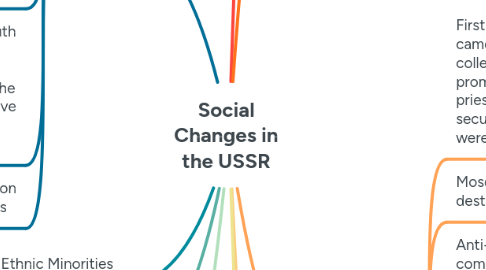
1. Youth
1.1. Invested heavily in Soviet youth and keeping them out of harms way/danger (WWI, Civil War, and famine for the most part.)
1.2. Despite the education systems flaws, youth were given oppourtunities in well-paid manual and technition jobs
1.3. Investment in public health increased parks, sports fields and other facilities for youth
1.4. Target of Soviet propaganda promoting themes of hope and solidarity, therefore youth were the most enthusiastic members of the campaign
1.5. Komsomol is similar to Hitler Youth but for Russia, a way for the younger generation to 'get involved' with communism and the party. They tried to promote active and cultured living among the soviet youth
1.6. By 1941 there were over 10 Million members of youth organisations
2. National and Ethnic Minorities
3. Consumption, shortages and Hardship
4. Women, Gender and Sexuality
4.1. secular marriages were made law rather than in religious places, are well as de-facto relationships
4.2. establishment of equal enheritance laws for sons and daughters
4.3. free childcare centres and nurseries for working mothers
4.4. 16-week maternity leave to encourage women to have kids as well as stay in the workforce
5. Education
5.1. Increased education funding by 400% 1932-37
5.2. School children increased from 12 million to 31 million by 1940
5.3. larger basic education for the the working, rural and urban population for all
5.4. Funding
5.5. Technical collleges with one million enrolments
6. Healthcare
6.1. Continued to emphasise the general importance of public health (tried to expand government efforts to increase knowledge about health and sanitation)
6.2. Imrpovement to the system included:
6.2.1. propaganda emphasised the importance of hygiene in the home
6.2.2. the 1936 Soviet Constitution enshrined free and universal healthcare for Soviet citizens
6.2.3. improvememnts to Soviet health services, health professionals had contact wth European specialists through journals, books, international organisations and even LoN
6.2.4. the Soviet medical system avoided the 'racial pathology' which was popular n Europe, north Maerica and was expressed in the Nazi regime
6.3. The promise of healthcare was greater than the reality
6.3.1. general decline in consumption, poor living conditions. Famine became a deadly issue
6.3.2. lack of healhcare resources across the USSR made healthcare difficult
6.3.3. doctors not allowed to practise privately, therefore all the major health services were tied to the government and specific places (workplaces)
6.3.4. overall there was a promise, but not the funds and resources to support their promises
7. Religion
7.1. First of Stalin's attacks on religion came with the beginning of the collectivisation. Due to being prominent community members priests were targeted by police and security forces, thousands of priests were arrested
7.1.1. Another major wave of attacks against religious communities from 1937-38. Thousands of church leaders arrested, sent to gulags or executed.
7.2. Mosques and Churches were destroyed under Stalin's orders
7.3. Anti-religious propaganda became common, it was produced both by the government and loyal groups
7.4. April 1929, decree on Religious Associations established strict rules on how religious groups could operate. Islamic ritual of Hajj was outlawed for Soviet citizens in 1935
7.5. Stalinist regime used agitators and sympathisers in religious attacks, most prominent one was the League of Militant Atheists.
7.5.1. The League was established in 1925 and reached peak of 5.6 million members in the early 1930s at a time when the communist party was just over 1.7 million
7.5.2. The league published the journal Bezbozhnik ('the godless'), covers included anti-religious propaganda.
7.5.3. League conducted anti-religious 'agitation' e.g. in a campaign against easter one slogan read: 'anyone who is for easter is against socialism'
8. The arts (music, art, film, literature)
8.1. All associations at the time were abolished and replaced by 'unions' for all of the arts
8.2. In Auguest 1934 the government announced 'socialist realism' as the only form of acceptable art in the USSR
8.3. Socialist realism was promoted across all artistic media such as film, paintings, poetry and plays
9. Urban vs Rural
9.1. Urban
9.1.1. Urban workers grew from 10%-34% from 1924-39
9.1.2. Number of engineers rose from 47,000 to 900,000 in 12 years.
9.1.3. New cities such as Magnitogrosk were constructed, and town planning and leisure areas were constructed.
9.1.4. o There was an aim to improve sanitation and automation, but these were not realised. Only 1/3 residents in Moscow had running water.
9.2. Rural
9.2.1. Severe hardships amongst 70% of the population amongst the countryside. Famines caused far more deaths than the mass state violence between 1936-38
9.2.2. Didn’t receive services and consumer goods like the cities, only received 30% of goods.
9.2.3. Decline in the infant mortality rate. Pay for collective farmers was less than workers and usually distributed as food and resources, not cash
